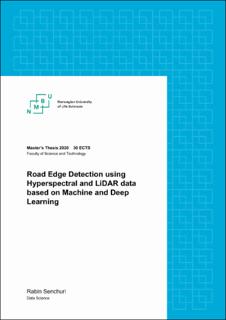| dc.contributor.advisor | Burud, Ingunn | |
| dc.contributor.advisor | Kuras, Agnieszka | |
| dc.contributor.author | Senchuri, Rabin | |
| dc.coverage.spatial | Norway | en_US |
| dc.date.accessioned | 2021-01-31T16:38:49Z | |
| dc.date.available | 2021-01-31T16:38:49Z | |
| dc.date.issued | 2020 | |
| dc.identifier.uri | https://hdl.handle.net/11250/2725447 | |
| dc.description.abstract | The mapping and classification of urban areas play a crucial role in the planning of the city and monitoring of various natural hazards that could occur in the future. It is also necessary for evaluating large-scale changes that occur in urban areas like building and road construction. Road edge detection is one of the key aspects of urban planning, as it is necessary to monitor street water levels and to monitor floods and landslides. High spatial and spectral resolution remotely sensed images called hyperspectral images are required to classify urban areas as roads and non-roads. In this study, LiDAR data collected from aircraft were used in combination with hyperspectral images to increase the accuracy of the classification. Hyperspectral and LiDAR data were collected from the Sandvika area using a hyperspectral and LiDAR sensor mounted on the aircraft. The data collected were pre-processed and corrected atmospherically. The classification was performed using machine learning and deep learning algorithms. Finally, the road edges were extracted using Canny Edge Detection Algorithm.
For this analysis, the LiDAR-hyperspectral image fusion approach was used and the fusion was pixel-wise based on hyperspectral and LiDAR data features. Hyperspectral features were derived using the Principal Component Analysis and Normalized Difference Vegetation Index, and the LiDAR features were based on the Normalized Digital Surface and Intensity Model. The classification models used for this study were Support Vector Machine, Random Forest and Convolutional Neural Network. Efficiency of each model was evaluated and optimization was performed in order to obtain the best model. Random Forest outperformed both SVM and CNN on the data classification.
Similarly, there were two types of data; the radiance and the atmospherically corrected data. Atmospherically corrected data is called reflectance data. The classification was performed on both the data and the performance of the radiance data (88% f1-score) was higher than the reflectance data. The approach demonstrated here can be widely applied in the classification and monitoring of urban areas experiencing major change. | en_US |
| dc.language.iso | eng | en_US |
| dc.publisher | Norwegian University of Life Sciences, Ås | en_US |
| dc.rights | Attribution-NonCommercial-NoDerivatives 4.0 Internasjonal | * |
| dc.rights.uri | http://creativecommons.org/licenses/by-nc-nd/4.0/deed.no | * |
| dc.subject | Remote Sensing | en_US |
| dc.subject | Hyperspectral Imaging | en_US |
| dc.subject | LiDAR | en_US |
| dc.subject | Machine Learning | en_US |
| dc.title | Road edge detection using hyperspectral and LiDAR data based on machine and deep learning | en_US |
| dc.type | Master thesis | en_US |
| dc.subject.nsi | VDP::Mathematics and natural science: 400::Information and communication science: 420::Simulation, visualization, signal processing, image processing: 429 | en_US |
| dc.subject.nsi | VDP::Mathematics and natural science: 400::Information and communication science: 420::Theoretical computer science, programming languages and programming theory: 421 | en_US |
| dc.subject.nsi | VDP::Mathematics and natural science: 400::Geosciences: 450::Other geosciences: 469 | en_US |
| dc.source.pagenumber | 106 | en_US |
| dc.description.localcode | M-MF | en_US |

